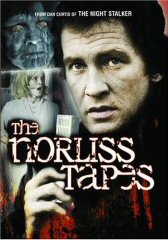
With an effective minimalist writing style and paranoid way of looking at the seemingly natural, William F. Nolan has made a career out of questioning the shifting definitions of what constitutes reality. Charging the commonplace with terror, focusing on transformations via the outré, his work for television and film come close to achieving the terror of his friend Richard Matheson's pairings with Dan Curtis, who filmed The Night Stalker and Trilogy of Terror together. Combining horror with intelligence, fantasy with believable human conflict, Nolan and Curtis explore humanity in both its ugliest and most resilient incarnations. A leaf-burnt, pumpkin glowing adventure carved into the heart of the supernatural, The Norliss Tapes is both a trick and a treat for the upcoming Halloween season. Originally created as a series pilot, this subtle take on the occult -- taken, it seems, right from the mysterious shadow of life's shadow-drenched byways -- captures the essence of the unknown in the very insistence of its principle characters to question the occult, allowing Curtis to milk a thoughtful, suspenseful conflict between the normal and uncanny. He does this with customary panache, showing once again his understanding of what scares us.
Author David Norliss (Roy Thinnes), a reporter specializing in the supernatural, disappears after requesting a meeting with his publisher (Don Porter). The publisher discovers at Norliss' house a large number of cassette tapes, each of which contains notes on occult investigations. Playing the first tape, the publisher hears the story of Ellen Cort (Angie Dickinson), who one night, while investigated her dead husband's art studio, is attacked by her dead husband (Nick Dimitri). Norliss promises to investigate. Elsewhere, another recently dead person shows marks of having been drained of blood. As these macabre elements play out, we discover that Cort may have been much different than his appearance suggested, a practitioner of the black arts. Pacts with demons and a quest for eternal life center around a mystical statue, resulting in a taunt viewing experience.
Evoking the essence of the unknown, as well as our human need to try and understand it, The Norliss Tapes is a 'quiet,' atmospheric nightmare of secret agenda. A sadly underappreciated love note to the fire within the human spirit, Curtis' inspired treatment of Nolan's menacing screenplay offers several moments of inspired panic. While characters are not explored with the efficiency showed in such Curtis directed pieces as Night Stalker, and while the plot isn't as energized as those vignettes that comprised Trilogy of Terror, the duet of Nolan and Curtis maintain an impressive mark of energy and craftsmanship, finding horror hidden within the folds of the everyday -- happenings, accidents, and characters typical in appearance, which really hide the essence of the numinous. A spirit of melancholy beauty surrounds the characters, and the lyrical descriptions of occult manifestations -- which Curtis excelled in -- lend this disturbing drama the cosmic resonance of a folktale. Exchanging the moldering castle environments and archaic concerns of traditional horror fiction (itself largely informed by the Gothic school of fiction) with instantly recognizable settings, Nolan depicts the mind in conflict with itself. This film discovers terror at the breakfast table, evil where science and modern cynicism tells us we should find nothing. The Norliss Tapes doesn't scream, it whispers. More to the point, Curtis displays his continued ability to dig beneath the surface of illusionary so-called '[reality.' Rather than creating a world of normalcy where the supernatural slowly intrudes, as do many traditional authors, or rushing readers headlong into a world where their exist no rules, he creates his own sense of order, his own shadow of realism -- a borderland between the real and imaginary.
Visual clarity is key here, Anchor Bay treating this rare television treat as though it were a feature film. While nothing can make up for its television 'feel,' and a pan-and-scan approach robs it of what could have very well been a beautiful depiction of decadence, for the most part the story is served well by its full frame transfer, contributing a sense of claustrophobia to the story. Audio in Dolby Digital is less satisfying than a majority of Anchor Bay's titles, with dialogue a bit soft, but for the most part music and effects are enjoyably translated without complication. Extras are sparse, but that isn't to be wondered at considering the small following this piece enjoys. They include trailers for The Entity, Quicksilver Highway, Race with the Devil, and Bad Dreams.
Review by William P. Simmons
| Released by Anchor Bay |
| Region 1 - NTSC |
| Not Rated |
| Extras : |
| see main review |